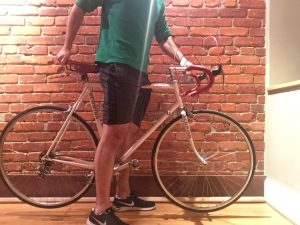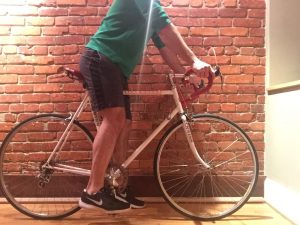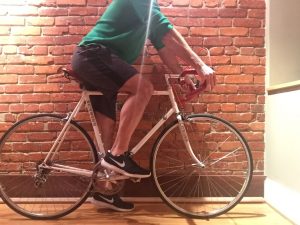
Washington D.C. is a frequent entry on “Most Bike-Friendly Cities in America” lists across the media landscape.1 With over 50 miles of bike lanes on city streets,2 hundreds of miles of paved bike trails, bicycle tours of the monuments, and a bike share service with over 3,000 rentable bikes,3 it’s no surprise so many DMV area residents get around on two wheels.
In addition to being a fun and environmentally friendly mode of transit, cycling is a great way to incorporate more exercise into your daily routine. Since cycling is non-weight bearing, it puts very little stress on lower body joints, making it an ideal form of exercise for those with arthritis or recovering from an injury or surgery. Additionally, modern gearing and the varied terrain of the DMV area make it easy to scale the intensity of cycling to almost any level of fitness.4 Even though cycling has many benefits, you can expose yourself to injury if your bike and your body aren’t properly prepared for your next ride.
Common bike injuries
When talking about injuries, most people think of accidents and crashes. While this is a reality that all cyclists must face, most tend to suffer non-traumatic musculoskeletal injuries. Ill-fitting bikes and poor fitness can lead to problems like patellar tendonitis, IT band syndrome, lower back pain, and hamstring strains.5
The good news is that there are a few simple adjustments and exercises that you can implement to reduce the risk of a bicycle injury. Follow these tips to make sure your bike and body are both prepared for your commute, weekend excursion, or next century ride.
Bike setup6
1. Bike size
Straddle your bike with both feet flat on the ground and lift your bike up as high as you can. You should be able to lift the bike about 1–2” off the ground before it makes contact with you. If you can’t straddle your bike with feet flat, or there is more than 2” of clearance, you should consider getting a bike sized more appropriately for you. If your bike frame is the wrong size for you, it will be very difficult to make enough adjustments to the seat, handlebars, and tires to make that bike work for you.

2. Seat height
Sit on your bike seat and put one foot on the pedal. Bring that pedal to the 6 o’clock position. At the bottom of the down stroke, your knee should be almost straight. If your knee is still flexed or you are able to hyperextend your knee, you need to adjust the height of your seat.

3. Seat fore/aft position
Sit on your bike seat and put one foot on the pedal. Bring that pedal to the 3 o’clock position and look at the position of your kneecap relative to the pedal. The kneecap should ideally be directly above the center of the pedal. If your kneecap is too far forward, you will risk quadriceps and patellar tendon injuries. If your kneecap is too far back, you will put your hamstrings at risk. Adjust the fore/aft position of your seat accordingly.

Strength exercises (perform 2–3 times per week on non-consecutive days)
Forward planks: Lie on your stomach and then prop yourself up on your forearms and toes. Keep your shoulders engaged, your stomach pulled in, and your glutes squeezed. Hold this position for 3–5 sets of 30–60 seconds. To make it more difficult, prop your elbows on a theraball and try the “stir the pot” variation.
Side planks: Lie on your side and prop yourself up on your bottom forearm and side of your foot. Like the forward plank, keep your shoulder, core, and glutes active to ensure good body position. Do 3–5 sets of 30–60 seconds. Add a leg lift to make this more difficult.
Hamstring curls: Lie on your back with your feet on a theraball. Lift your hips off the ground and then roll the ball towards your buttocks. Keep your abs and glutes engaged throughout the movement. Try 3–5 sets of 10–15 reps.
Stretches and mobility (perform 1–2 times/day and as a warm-up/cool down before and after bike rides)
Hip flexor stretch: Assume a half-kneeling position with the front foot positioned so that the front knee is at a 90° angle. Tilt your pelvis back / “tuck” your hips underneath your body by squeezing your glutes. If done properly you should feel a gentle stretch in front of the hip on the kneeling side. Hold for 30 seconds, switch sides, and repeat 3 times on each leg.
Hamstring stretch: Sit at the edge of a chair and straighten one leg. Sit up tall and lean forward through your hips, keeping your back straight. You should feel a gentle pull along the back of your whole leg. Hold for 30 seconds, switch sides, and repeat 3 times on each leg.
Low back stretch: Stand next to a doorway and reach overhead, grabbing the door frame with both hands. Cross your outside leg behind your body and then lean away from the doorway until a stretch is felt along the side of your trunk and hip.
Want to know more?
For more information about preventing or treating lower back pain, knee tendonitis, or other bike injuries, email us or request an appointment. Be sure to follow us on Facebook and Twitter as well!
 Kevin McGuinness is a physical therapist at the SMARTherapy Center at Washington Orthopaedic & Sports Medicine and is a Certified Strength and Conditioning Specialist. He received his Doctor of Physical Therapy degree from George Washington University in 2013 and works with a wide range of patient populations, including high school, college, and professional athletes, as well as patients with spinal cord and traumatic brain injuries.
Kevin McGuinness is a physical therapist at the SMARTherapy Center at Washington Orthopaedic & Sports Medicine and is a Certified Strength and Conditioning Specialist. He received his Doctor of Physical Therapy degree from George Washington University in 2013 and works with a wide range of patient populations, including high school, college, and professional athletes, as well as patients with spinal cord and traumatic brain injuries.
References:
- http://www.travelchannel.com/interests/outdoors-and-adventure/articles/top-10-cycling-cities-in-us
- http://ddot.dc.gov/sites/default/files/dc/sites/ddot/publication/attachments/bike_lane_count_fact_sheet_2011.pdf
- http://www.capitalbikeshare.com
- http://citeseerx.ist.psu.edu/viewdoc/download?doi=10.1.1.683.497&rep=rep1&type=pdf
- https://www.rei.com/learn/expert-advice/bike-fit.html
